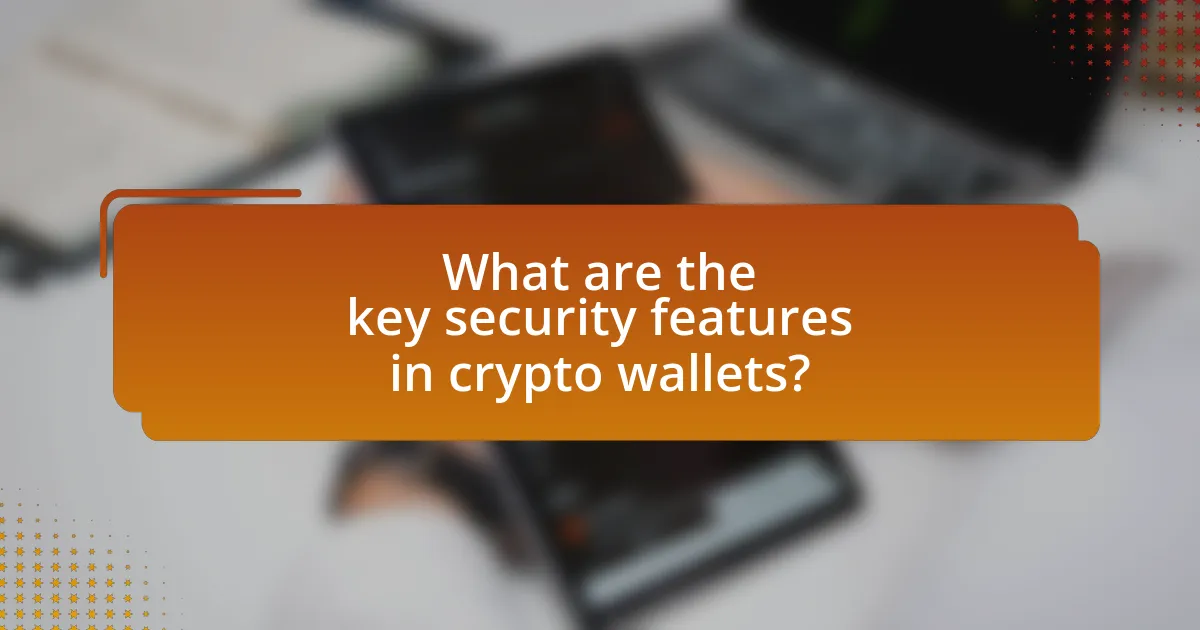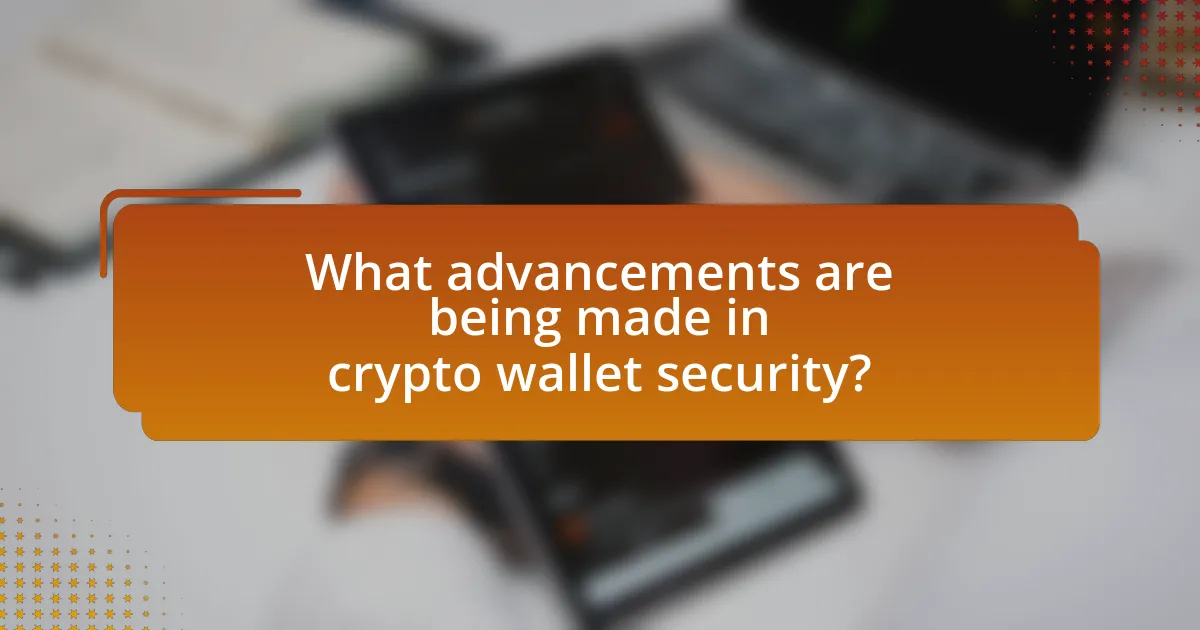The article focuses on enhancing security features in crypto wallets to improve user experience. It outlines key security measures such as private key management, two-factor authentication, encryption, and backup options, which collectively protect users’ assets from theft and unauthorized access. The discussion includes the importance of user education in recognizing threats, common security risks like phishing and malware, and advancements in wallet security, including biometric authentication and decentralized storage. Additionally, best practices for secure wallet usage and tips for selecting a reliable wallet provider are provided, emphasizing the critical role of security in fostering user trust and satisfaction.

What are the key security features in crypto wallets?
The key security features in crypto wallets include private key management, two-factor authentication (2FA), encryption, and backup and recovery options. Private key management ensures that users have sole control over their keys, which are essential for accessing their funds. Two-factor authentication adds an extra layer of security by requiring a second form of verification, such as a code sent to a mobile device, before allowing access to the wallet. Encryption protects sensitive data stored within the wallet, making it unreadable to unauthorized users. Backup and recovery options allow users to restore their wallets in case of loss or theft, ensuring continued access to their assets. These features collectively enhance the security of crypto wallets, safeguarding users’ investments against theft and unauthorized access.
How do these security features enhance user experience?
Security features enhance user experience by providing users with confidence and peace of mind when managing their assets. When users know their information and funds are protected through measures such as two-factor authentication, encryption, and biometric access, they are more likely to engage with the platform without fear of breaches. Research indicates that 70% of users prioritize security in their digital transactions, which directly correlates with increased user satisfaction and retention. Enhanced security not only protects users but also fosters trust in the platform, leading to a more seamless and enjoyable experience overall.
What role does encryption play in securing crypto wallets?
Encryption plays a critical role in securing crypto wallets by protecting sensitive information, such as private keys and transaction data, from unauthorized access. This protection is achieved through algorithms that convert plaintext data into ciphertext, making it unreadable to anyone without the correct decryption key. For instance, wallets often use advanced encryption standards like AES-256, which is widely recognized for its robustness and is employed by various security protocols globally. By ensuring that only authorized users can access their wallet information, encryption significantly reduces the risk of theft and fraud, thereby enhancing the overall security of crypto wallets.
How does two-factor authentication improve wallet security?
Two-factor authentication (2FA) significantly enhances wallet security by requiring users to provide two distinct forms of identification before accessing their accounts. This dual-layered approach mitigates the risk of unauthorized access, as even if a malicious actor obtains the user’s password, they would still need the second factor, typically a code sent to a mobile device or generated by an authentication app, to gain entry. According to a study by Google, implementing 2FA can block 99.9% of automated attacks, demonstrating its effectiveness in safeguarding sensitive information and assets within crypto wallets.
Why is user education important for wallet security?
User education is crucial for wallet security because it empowers individuals to recognize and mitigate potential threats. Educated users are more likely to implement best practices, such as using strong passwords, enabling two-factor authentication, and being aware of phishing attempts. According to a study by the Cybersecurity & Infrastructure Security Agency, 90% of successful cyber attacks are due to human error, highlighting the importance of informed user behavior in preventing security breaches. By understanding the risks and proper security measures, users can significantly reduce the likelihood of unauthorized access to their wallets.
What common security threats do users face with crypto wallets?
Users face several common security threats with crypto wallets, including phishing attacks, malware, and private key theft. Phishing attacks involve deceptive communications that trick users into revealing sensitive information, such as wallet credentials. Malware can infect devices, allowing attackers to gain unauthorized access to wallets and steal funds. Private key theft occurs when users inadvertently expose their keys through insecure storage or sharing practices, leading to loss of assets. According to a report by Chainalysis, in 2021, over $7.7 billion was stolen from cryptocurrency users, highlighting the prevalence of these threats.
How can users protect themselves from phishing attacks?
Users can protect themselves from phishing attacks by implementing multi-factor authentication (MFA) on their accounts. MFA adds an extra layer of security by requiring not only a password but also a second form of verification, such as a text message code or authentication app. According to a study by Google, MFA can block 99.9% of automated attacks, significantly reducing the risk of unauthorized access. Additionally, users should be cautious of unsolicited emails or messages that request personal information, as these are common phishing tactics. Regularly updating passwords and using unique passwords for different accounts further enhances security against phishing attempts.

What advancements are being made in crypto wallet security?
Advancements in crypto wallet security include the implementation of multi-signature technology, biometric authentication, and hardware wallet integration. Multi-signature technology requires multiple private keys to authorize a transaction, significantly reducing the risk of unauthorized access. Biometric authentication, such as fingerprint or facial recognition, enhances user verification processes, making it harder for unauthorized users to gain access. Additionally, hardware wallets, which store private keys offline, provide a robust layer of security against online threats. According to a report by Chainalysis, the use of multi-signature wallets has increased by 30% in the past year, indicating a growing trend towards enhanced security measures in the crypto space.
How are biometric features being integrated into crypto wallets?
Biometric features are being integrated into crypto wallets primarily through fingerprint recognition, facial recognition, and iris scanning to enhance security and user experience. These biometric methods provide a secure and convenient way for users to authenticate transactions and access their wallets, reducing reliance on traditional passwords, which can be vulnerable to theft. For instance, many mobile crypto wallets now utilize the fingerprint sensors available on smartphones, allowing users to unlock their wallets quickly and securely. Additionally, facial recognition technology is increasingly being adopted, as seen in wallets that support devices with advanced camera systems, enabling users to authenticate their identity with a simple glance. This integration not only improves security by ensuring that only authorized users can access the wallet but also streamlines the user experience by making the authentication process faster and more intuitive.
What are the benefits of using biometric authentication?
Biometric authentication enhances security by providing a unique and difficult-to-replicate method of verifying identity. This technology utilizes physical characteristics such as fingerprints, facial recognition, or iris scans, making unauthorized access significantly more challenging. According to a study by the National Institute of Standards and Technology, biometric systems can achieve accuracy rates exceeding 99%, which is substantially higher than traditional password systems that are often vulnerable to theft or guessing. Additionally, biometric authentication improves user experience by streamlining the login process, reducing the need for complex passwords, and minimizing the risk of forgotten credentials.
How does biometric security compare to traditional methods?
Biometric security offers a more advanced and user-friendly alternative to traditional methods such as passwords and PINs. Unlike traditional methods, which rely on something the user knows, biometric security utilizes unique physical characteristics like fingerprints, facial recognition, or iris scans, making it inherently more secure against unauthorized access. According to a study by the National Institute of Standards and Technology, biometric systems can achieve accuracy rates exceeding 99% in identifying individuals, significantly reducing the risk of breaches compared to traditional methods, which are often vulnerable to theft or guessing.
What role does blockchain technology play in enhancing wallet security?
Blockchain technology significantly enhances wallet security by providing a decentralized and immutable ledger for transactions. This decentralization reduces the risk of single points of failure, as data is distributed across a network of nodes, making it difficult for malicious actors to alter transaction records. Additionally, the cryptographic techniques used in blockchain, such as hashing and public-private key pairs, ensure that only authorized users can access and manage their wallets. For instance, the use of cryptographic signatures verifies the authenticity of transactions, preventing unauthorized access and fraud. These features collectively contribute to a more secure environment for storing and transferring digital assets.
How does decentralized storage improve security for users?
Decentralized storage improves security for users by distributing data across multiple nodes rather than storing it in a single location. This distribution reduces the risk of data breaches, as compromising one node does not grant access to the entire dataset. For instance, in traditional centralized systems, a single point of failure can lead to significant data loss or theft, whereas decentralized systems utilize encryption and redundancy to protect user data. Additionally, decentralized storage often employs blockchain technology, which provides an immutable record of transactions, further enhancing security by making unauthorized alterations nearly impossible.
What are the implications of smart contracts for wallet security?
Smart contracts significantly enhance wallet security by automating transactions and enforcing predefined conditions without the need for intermediaries. This automation reduces the risk of human error and fraud, as transactions are executed only when specific criteria are met, ensuring that funds are only transferred under agreed-upon conditions. Additionally, smart contracts operate on blockchain technology, which provides a transparent and immutable ledger, making it difficult for malicious actors to alter transaction records. The use of smart contracts can also facilitate multi-signature wallets, requiring multiple approvals for transactions, further bolstering security against unauthorized access.

What best practices should users follow for secure crypto wallet usage?
Users should follow several best practices for secure crypto wallet usage, including enabling two-factor authentication (2FA), using hardware wallets, and regularly updating wallet software. Enabling 2FA adds an extra layer of security by requiring a second form of verification, which significantly reduces the risk of unauthorized access. Hardware wallets, which store private keys offline, provide enhanced protection against online threats, as they are less susceptible to hacking. Regularly updating wallet software ensures that users benefit from the latest security patches and features, reducing vulnerabilities. According to a report by the Blockchain Security Alliance, implementing these practices can decrease the likelihood of theft and loss of funds in crypto wallets.
How can users choose the right crypto wallet for their needs?
Users can choose the right crypto wallet by assessing their specific needs, such as security, ease of use, and the types of cryptocurrencies they plan to store. For instance, hardware wallets offer enhanced security for long-term storage, while software wallets provide convenience for frequent transactions. According to a 2021 survey by Statista, 39% of cryptocurrency users prioritize security features when selecting a wallet, highlighting the importance of robust encryption and two-factor authentication. Additionally, users should consider wallet compatibility with various cryptocurrencies, as some wallets support a wider range than others, ensuring they can manage their assets effectively.
What features should users prioritize when selecting a wallet?
Users should prioritize security features, user control, and ease of use when selecting a wallet. Security features include two-factor authentication, encryption, and backup options, which protect assets from unauthorized access and loss. User control is essential, as wallets that allow users to manage their private keys provide greater security and ownership of funds. Ease of use ensures that users can navigate the wallet interface without difficulty, enhancing their overall experience. According to a 2021 survey by Statista, 40% of cryptocurrency users consider security the most important factor when choosing a wallet, highlighting the critical nature of these features.
How can users assess the reputation of a wallet provider?
Users can assess the reputation of a wallet provider by researching user reviews, checking regulatory compliance, and evaluating security features. User reviews on platforms like Trustpilot or Reddit provide insights into the experiences of other customers, highlighting reliability and service quality. Regulatory compliance, such as adherence to KYC (Know Your Customer) and AML (Anti-Money Laundering) regulations, indicates a commitment to legal standards and user protection. Additionally, examining the wallet’s security features, such as two-factor authentication and encryption protocols, can reveal how well the provider safeguards user assets. These factors collectively contribute to a comprehensive understanding of a wallet provider’s reputation.
What are some practical tips for maintaining wallet security?
To maintain wallet security, users should implement strong passwords, enable two-factor authentication, and regularly update wallet software. Strong passwords should be complex, combining letters, numbers, and symbols, making them difficult to guess. Two-factor authentication adds an extra layer of security by requiring a second form of verification, such as a text message or authentication app, which significantly reduces the risk of unauthorized access. Regularly updating wallet software ensures that users benefit from the latest security patches and features, protecting against vulnerabilities. According to a report by the Cybersecurity & Infrastructure Security Agency, using these security measures can reduce the likelihood of successful cyberattacks on digital wallets.
How often should users update their wallet software?
Users should update their wallet software regularly, ideally every time a new version is released. Regular updates are crucial because they often include security patches, bug fixes, and enhancements that protect users from vulnerabilities. For instance, a study by the Cybersecurity & Infrastructure Security Agency (CISA) highlights that 85% of security breaches exploit known vulnerabilities, which can often be mitigated through timely software updates. Therefore, maintaining up-to-date wallet software significantly reduces the risk of security threats and enhances user experience.
What steps should users take if they suspect a security breach?
If users suspect a security breach, they should immediately change their passwords and enable two-factor authentication on their accounts. Changing passwords minimizes the risk of unauthorized access, while two-factor authentication adds an extra layer of security by requiring a second form of verification. Users should also review their account activity for any unauthorized transactions or changes, as this can help identify the extent of the breach. Additionally, users should notify their wallet provider or relevant service about the suspected breach, as they may have protocols in place to assist and mitigate further risks. Finally, users should consider monitoring their accounts and credit reports for any signs of identity theft, as breaches can lead to compromised personal information.


